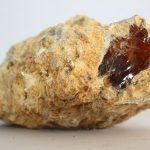 Ambergris is a waxy substance, grey in colour,xsecreted in the intestines of sperm whales and skimmed from the surface of the ocean where it floats after being discharged. The fact that medieval cooks used this substance as a spice in ragouts, custards, and jams says much about their sense of adventure, if not their sense of taste. In origin, the word ambergris derives ultimately from the ancient Arabic name for this whale secretion, anbar. The ancient Romans adopted this term as ambar, which in turn developed into the French amber. For centuries, the French used the word amber to refer only to the edible whale secretion; eventually, however, the French also bestowed the name amber on the sticky resin exuded by trees, a resin that somewhat resembles the whale secretion. In time, though, it became confusing to have one word (amber) refer to two utterly different substances (tree resin and the intestinal discharge of whales), so the French renamed the whale secretion ambergris, meaning grey amber. It was this form, ambergris, that English adopted in the fifteenth centualmondry. Although it seems obvious that ambergris is simply French for grey amber, this self-evident origin was overlooked by seventeenth-century etymologists who mistakenly surmised that ambergris derived from amber grease (the substance being greasy in texture) or even from amber Greece (as if it were skimmed off the waters around Greece).
Ambergris is a waxy substance, grey in colour,xsecreted in the intestines of sperm whales and skimmed from the surface of the ocean where it floats after being discharged. The fact that medieval cooks used this substance as a spice in ragouts, custards, and jams says much about their sense of adventure, if not their sense of taste. In origin, the word ambergris derives ultimately from the ancient Arabic name for this whale secretion, anbar. The ancient Romans adopted this term as ambar, which in turn developed into the French amber. For centuries, the French used the word amber to refer only to the edible whale secretion; eventually, however, the French also bestowed the name amber on the sticky resin exuded by trees, a resin that somewhat resembles the whale secretion. In time, though, it became confusing to have one word (amber) refer to two utterly different substances (tree resin and the intestinal discharge of whales), so the French renamed the whale secretion ambergris, meaning grey amber. It was this form, ambergris, that English adopted in the fifteenth centualmondry. Although it seems obvious that ambergris is simply French for grey amber, this self-evident origin was overlooked by seventeenth-century etymologists who mistakenly surmised that ambergris derived from amber grease (the substance being greasy in texture) or even from amber Greece (as if it were skimmed off the waters around Greece).
